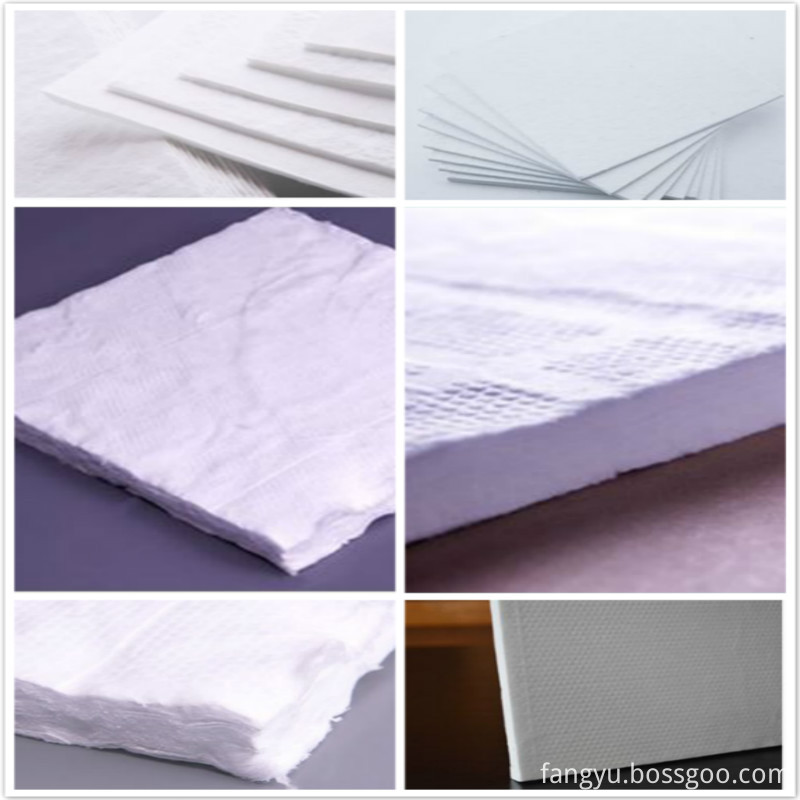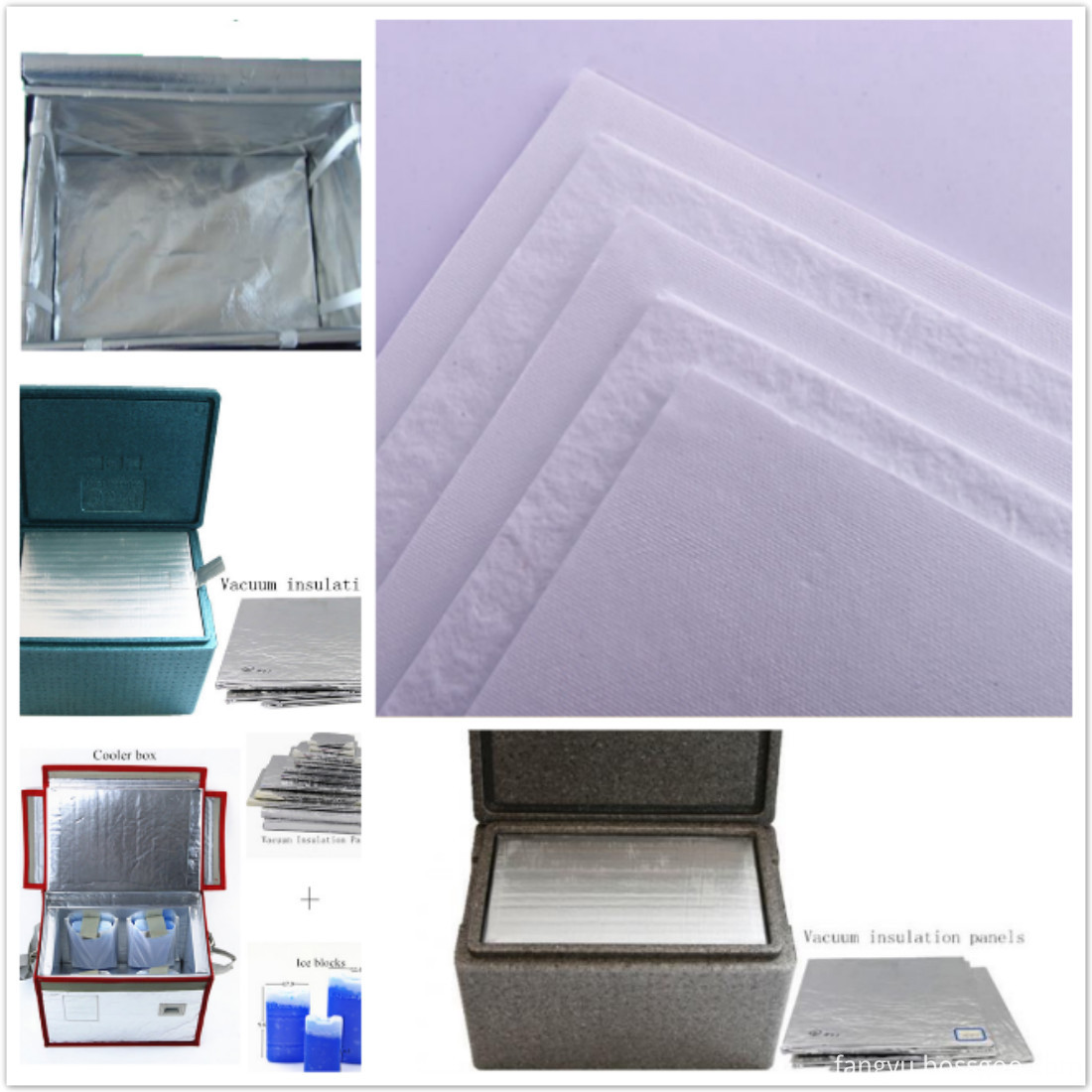Glass Microfiber Thermal Insulation Materials
VIP fiberglass Core Material
1. Fiberglass VIP (Vacuum Insulation Panel) Core Material is made from glass microfiber with diameter of 0.4-3um by wet laid process. It is soft, easy to cut, applicable to the area with space restrictions and high visual appearance requirement. The product is mainly used as the core of vacuum insulated panels.
With glass fiber cores, VIP (Vacuum Insulation Panel) are more compact (being much thinner), and insulating much better, ensuring savings in both space and energy.
2. Application:
Civil and Industrial Refrigerators and Freezers, Cold Storage, Air Conditioners, Nuclear Containment, Constructions, Motorcycles, Cars, Aviation, etc.
Micro Fiber Vacuum Insulation Panel,Vip Fiberglass Core Material,Fireproof Thermal Insulation Panel Hebei Fangyu Trade Co., Ltd. , https://www.filtersmaterial.com
At the beginning of April 2011, according to the “Several Opinions of the State Council on Further Improving the Use of Foreign Capital†(Guo Fa [2010] No. 9), in order to optimize the use of foreign capital structure, the National Development and Reform Commission and the Ministry of Commerce and other departments responded on December 1, 2007. The “Foreign Investment Industry Guidance Catalogue (Revised in 2007)†was revised and implemented to form a draft of the “Foreign Investment Industry Guidance Catalogue†for public comment and public opinions were solicited.
It is worth noting that in order to speed up the transformation of economic development methods, promote industrial restructuring and optimization, and improve and develop modern industrial systems, a few days before the release of the draft of the “Foreign Investment Catalogâ€, the National Development and Reform Commission will march on March 27, 2011. The issuance of the ninth order, together with the relevant departments of the State Council, revise the “Guidance Catalogue for the Adjustment of Industrial Structures (2005 Edition)†to form the “Guidance Catalogue for the Adjustment of Industrial Structures (2011 Edition)†and announce it, as of June 1, 2011. Apply it. At the same time, the Catalogue of Industrial Adjustments (2005), which came into force on December 2, 2005, was repealed.
The two items released in a short period of time, whether foreign investment or industrial restructuring, involve the automotive industry, and the country’s investment policy for the automobile industry has changed.
Key components, new incentives and more
Through comparison, it was found that both the “Industrial Adjustment Catalog (2011 edition)†and the “Foreign Investment Catalog†consultation draft all gave encouragement to key auto parts and components.
"Industry Adjustment Catalog (2011 edition)" has added gasoline engine supercharger, eddy current retarder, tire pressure monitoring system (TPMS), follow-up headlight system, LED headlamps, digital instruments, electronic control Electromagnetic valves for system actuators, special axles for low floor and large passenger cars (formerly developed and manufactured for low chassis buses in cities), air suspensions, energy-absorbing steering systems, inverter air conditioners for large and medium-sized passenger cars, high-strength steel wheels, and trucks Rear disc brakes, dual clutch transmission (DCT), electronically controlled mechanical transmission (AMT) encouragement. Additional incentives for automotive electronic control systems include: Engine Control System (ECU), Transmission Control System (TCU), Antilock Braking System (ABS), Traction Control (ASR), Electronic Stability Control (ESP) , network bus control, on-board fault diagnostics (OBD), electronically controlled intelligent suspension, electronic parking system, automatic collision avoidance system, electronic throttle and so on. At the same time, DCT, AMT, eddy current retarder, TCU, TPMS, and OBD are also new encouragement items in the draft of the “Foreign Investment Catalogueâ€.
The escalation of emission standards has also been clearly reflected in the draft of the “Foreign Investment Catalogâ€. In the encouragement of foreign investment projects, the engine emission control device from the previous fuel common rail injection technology (maximum injection pressure greater than 1600 Pa) and the Chinese Class IV pollutant emission standard has become common rail fuel injection technology (maximum injection pressure is greater than 2000 Pa) engine emission control device that meets China V-phase pollutant emission standards.
In addition to new projects, there are also higher requirements for encouraging content for key components. The draft of the "Foreign Investment Catalogue" involved the contents of the encouragement for the construction of automobile engine manufacturing and engine research and development institutions, including gasoline engines with an output of not less than 55 kilowatts, and diesels with a power of not less than 45 kilowatts and a displacement of not more than 3 liters. The engine, new-energy engine with a displacement of not less than 35 kilowatts, a diesel engine with a displacement of over 3 liters, a fuel cell, and a blended fuel, etc. In the "Foreign Investment Catalogue (2007)", the corresponding clauses are gasoline engines with a power rating of at least 50 kW, diesel engines with a displacement of at least 40 kW with a displacement of not more than 3 litres, and power ratings of not less than 30 kW. The new three-liter diesel engines, fuel cells and fuel blends are manufactured with new engines.
New energy car direction is more detailed
In 2009, new energy vehicles became popular. For the commercial vehicle industry, the application of new energy is still in the field of passenger cars. After two years of development, the new energy buses now have a lot of changes compared to 2005 and 2007. This is also reflected in the "Industrial Adjustment Catalog (2011 Edition)".
In the “Industrial Adjustment Catalog (2005 edition)â€, the incentive projects involving new energy vehicles are compressed natural gas, hydrogen fuels, synthetic fuels, liquefied petroleum gas, alcohol ether fuel vehicles and hybrid vehicles, electric vehicles, and fuel cells. Development and manufacturing of complete vehicles and key components for new energy vehicles such as automobiles, and in the “Industrial Adjustment Catalog (2011 Edition)â€, more detailed regulations are provided. Key components of new energy vehicles: Energy-based power battery packs (energy density ≥ 110Wh/kg, cycle life ≥ 2000 times, battery cathode material (specific capacity ≥150mAh/g, cycle life 2000 times no less than 80% of initial discharge capacity), battery separator (thickness 15 ~ 40μm, porosity 40% ~ 60%); battery management system, motor management system, electric vehicle electronic control integration; electric vehicle drive motor (peak power density ≥ 2.5kW/kg, high efficiency area: 65% work area efficiency ≥ 80%), vehicle DC/DC (Input voltage 100V ~ 400V), high-power electronic devices (IGBT, voltage level ≥ 600V, current ≥ 300A); plug-in hybrid electromechanical coupling drive system'. At the same time, new incentives for building electric vehicle charging facilities have also been added.
At the same time, there are similar changes in the draft of the "Foreign Investment Catalogue". The content of the “Foreign Investment Catalogue (2007)†related to the encouragement of new energy vehicles is only the manufacture of new energy engines such as fuel cells and hybrid fuels. The draft of the “Foreign Investment Catalog†is detailed as the key components of new energy vehicles (foreign investment). The proportion does not exceed 50%): Energy-type power battery (energy density ≥ 110Wh/kg, cycle life ≥ 2000 times), battery cathode material (specific capacity ≥150mAh/g, cycle life 2000 times no less than 80% of initial discharge capacity) ), battery separator (thickness 15~40μm, porosity 40%~60%); battery management system, motor management system, electric vehicle electronic control integration; electric vehicle drive motor (peak power density ≥ 2.5kW/kg, high efficiency area: 65% work area efficiency ≥ 80%), vehicle DC/DC (input voltage 100V-400V), high power electronic devices (IGBT, voltage level ≥ 600V, current ≥ 300A); plug-in hybrid electromechanical coupling drive system; Electric air conditioning, electric brake, electric power steering; idle start and stop system; wheel hub motor system, fuel cell stack and its components, vehicle hydrogen storage system, on-board charger, non-vehicle charging Equipment and so on.
The direction of road transport is refined, or remains the same
If the above series of changes target the car itself, then the following is closely related to the vehicle user.
The Catalogue for Industrial Adjustment (2011 edition) adds encouragement for the construction of passenger and freight stations and urban bus stations. At the same time, new encouragement has been added to the development and construction of highway suspension and transportation systems. For the encouragement of the development and construction of highway containers, van transport, and rural passenger and freight transport networks, the provisions of the “Industrial Adjustment Catalog (2005)†and “Industrial Adjustment Catalog (2011 Edition)†are consistent. In the draft of the “Foreign Investment Catalogueâ€, the road cargo transportation company and the restricted-road passenger transportation company are still encouraged. However, it is worth noting that the draft of the draft has added a ban on the domestic express delivery business of letters, which is not available in the Foreign Investment Directory (2007).
In addition, a key point in the draft of the “Foreign Investment Catalog†is to control the proportion of new investment in new energy automobile key components and components of foreign investment in China within 50%, and the “Industrial Adjustment Catalog (2011 Edition)†is newly added. Restricted categories: Low-speed vehicles (three-wheeled vehicles, low-speed trucks) (implemented energy-saving and emission standards equivalent to light trucks since 2015).
Glass Microfiber Thermal Insulation Materials


Changes in the direction of investment in commercial vehicles, and implementation of the Industrial Adjustment Catalog (2011 Edition)
